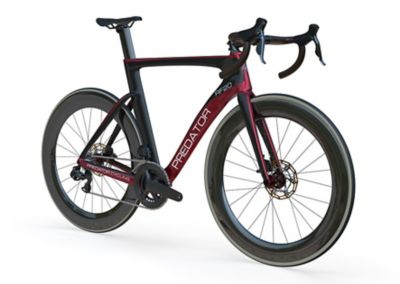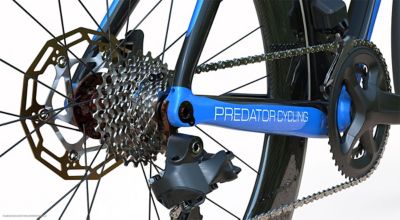ANSYS BLOG
March 19, 2021
Predator Cycling Optimizes the Cycling Experience With Simulation

Predator Bicycle used Ansys Discovery to help design its RF20 bike.
When Aram Goganian was an avid 14-year-old bike racer, he became impatient with a company that he felt was taking too long to produce a new time trial bike.
“I told them it’s not that complicated,” Goganian recalls. “That they should hurry up and do it. The company owner said, ‘If it’s that simple, you should do it.’” So he did.
Twenty-two years later, he is still designing unique bikes and accessories at his company Predator Cycling, only now he’s using Ansys Discovery, Ansys Mechanical, topology optimization and Ansys Composite PrepPost to produce everything from his latest carbon fiber-based bike, the RF20, to 3D-printed water bottle cages that securely hold a water bottle in place on even the wildest mountain bike rides. He uses the new Lenovo ThinkStation P620 equipped with the NVIDIA RTX A6000 GPU and a 64-core Threadripper Pro processor built on the new Ampere architecture to run the simulations in record time. Goganian started using Ansys simulation solutions as a member of the Ansys Startup program in early 2020, right when he was having some trouble with the design of the RF20.
“We started using Ansys simulation and it was a huge game changer because we could actually simulate so many things before we went to prototyping,” he says. “We saved at least seven or eight months of additional R&D by being able to simulate so much earlier on in the design process.”
Winning With Simulation of the RF20 Bike
Goganian was only 15 when he produced his first “gnarly-looking” prototype bike, as he describes it. Other racers saw it and wanted to buy one. Suddenly he was in business. From the start, his idea was to build the fastest bike and win bike races.
“Winning bike races doesn't always mean that you have the lightest bike,” he explains. “It’s more of a balancing act between total weight, weight distribution, aerodynamics, frame stiffness, impact tolerance, bike fit, biomechanics, the shortest chain stays and other factors.”
For the RF20 road bike, the Predator Cycling team designed and built an entirely new product from the frame to the smallest detailed components, including a purpose-built bottom bracket system — a hollow cylinder at the bottom of the frame into which the bike’s cranks fit, along with the axle and bearings. They also spent a lot of time designing the rear dropouts — the two small hanger notches in the back of the bike where the rear wheel goes. Although a dropout looks like a simple thing, Goganian redesigned it three times — the last time using Discovery — to ensure it would last a long time. Goganian is a perfectionist with his products.
He is also using Ansys Composite PrepPost to design new handlebars for the RF20. As you might expect, he is breaking new ground here too, fusing together a prepreg carbon fiber (a reinforcing fabric that is pre-impregnated with a resin system) and a high-temperature 3D print material into a single part.
Simulating the Genius Water Bottle Cage
 Left to right: Initial, in-progress and completed versions of Predator Bicycle's Genius water bottle holder, which was optimized with Ansys Discovery.
Left to right: Initial, in-progress and completed versions of Predator Bicycle's Genius water bottle holder, which was optimized with Ansys Discovery.
With a goal of having a complete line of cycling-related products that they can 3D-print in-house and sell directly to consumers, Goganian used Discovery’s topology optimization functionality to design a revolutionary new bottle cage. While a device that attaches to the frame of a bike to hold a water bottle doesn’t seem like it should require much in the way of engineering innovation, it does if you work for Predator Cycling. Goganian wanted it to be the most efficient, durable and easy-to-use bottle cage on the market.
“Bottles are ejected from cages all the time, especially when you are mountain biking over rough terrain,” Goganian says. “This can be dangerous and inconvenient, and it slows you down.”
The entry angle is one important parameter. How does the bottle enter the cage? At what angle?
“Traditionally you couldn't go in on the side,” he explains. “You had to come in straight from the top. We designed ours with a mouth that looks like a shark mouth opening. The idea was that you could come in from almost a 45-degree angle and insert the bottle. You can come in from the top almost straight down and access it. It makes it easy. The material properties of the cage make it super flexible. You can actually bend and twist it and it will just grab the bottle.”
Goganian came up with the idea for the Genius water bottle cage about three years ago, but he wasn’t able to build it until he had the topology optimization feature of Discovery at his fingertips, which starts with a standard design and analyzes where material can be removed without reducing performance.
You can watch an animation of the Genius bottle cage topology automation using Discovery on the Predator Cycling website, showing how topology optimization automatically removes material from the design to go from the starting shape to the nearly final shape.
“I absolutely love topology optimization,” he says. “It’s my favorite thing ever. We had this idea for a bottle cage that would be the perfect thing to 3D print, but we could never figure out how to do it until we found Discovery.”
The bottle cage is made of an UV-activated resin that is then post-cured with a thin ceramic coating. Goganian liked that Discovery allowed him to import his own custom materials for the simulations. By adding a ceramic coating, he was trading some weight (the Genius bottle cage weighs 20 grams, while the lightest cage on the market weighs around 16 grams) for durability. The ceramic coating protects the cage from damaging UV rays and helps it retain its original color.
“One of the things about cages that drives me nuts is they change color over time because the bottle cage goes in and out of it and it rubs against the cage. The ceramic coating we have actually has a lubricating property to it to help the cage go in and out. It makes the cage more durable. Also, in cycling, you're dealing a lot with sweat and salt and energy drinks and sugar, which just eat through and destroy everything. The ceramic prevents this kind of destruction.”

An All-Access Startup Program
Besides the attractive price point of the Ansys Startup Program, Goganian loves that it gives him instant access to complete Ansys products in an approach that he describes as “Here's everything. Use whatever you want and figure it out. We’ll help you if you need it.” Having a complete package meant that he didn’t have to worry that he would get halfway through a design project and find that he didn’t have access to some software that would prevent him from completing it.
He also likes being part of the larger engineering community.
“I’m using the same simulation software to build bicycles that aerospace companies are using to build rockets,” Goganian says. “That's pretty cool.”
